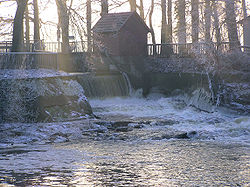Hare attack

Hase attack , also called Schützenhofwehr , is the name of a weir (transverse structure) that no longer exists today with an artificial waterfall ( ⊙ ) in the course of the Hase at Quakenbrück in the Lower Saxony district of Osnabrück . It was located near the Schützenhof and the beginning of the attack hare and was replaced in 2013 by a bottom slide .
Changes in the course of the rabbit
Even before hydraulic engineering measures began, the Hase branched out into numerous river arms due to its low gradient and formed an inland delta . Natural damming effects often resulted in harmful and threatening flooding of settlements, although flooding was only desired in agricultural areas.
To protect against floods from Quakenbrück and the towns below it, the Hase was dammed a little southwest of the city center. Since 1683 it has been pouring into a significantly lower side arm, the Überfallhase , which flows around the city in a northerly direction, and into the Kleine Hase, in which a lock was built a little west of the Haseüberfall to control the water flow through the old town of Quakenbrück .
The big hare begins with the attack hare . Further hydraulic engineering measures were required, in particular the construction of the Essen Canal , so that there were no major floods further downstream, for example in the Essen area . Since then, only surface water from the districts of Cloppenburg and Vechta has flowed past the center of Essen, which was previously located on the Großer Hase .
The course of the little rabbit was also radically changed by human intervention. As can be seen from old maps, the little hare used to flow into the big hare near Löningen . Today's Kleine Hase begins as a water tee of the Großer Hase at the former Schützenhofwehr. Together with a sluice in the Kleiner Hase in its immediate vicinity, this controlled the outflow of the Kleiner Hase before Quakenbrück until 2013. The Kleine Hase flows below Menslage with a dam into the Hahnenmoorkanal , which feeds its water into the Große Hase after nine kilometers at Aselage (a former manor district belonging to Herzlake ) around 13 km below the former mouth of the Kleiner Hase. This protects Löningen from the floods from the Little Hare. The high heel at the beginning of the canal or in the river bed of the Hase represents an obstacle that is insurmountable for all upward migrating river organisms that use the Little Hare. Today, however, these can reach the upper reaches of the river via the Große Hase (due to the construction of the bottom slip in the Raid Hare).

History of the Schützenhofwehr
In 1901 the attack on the Schützenhof consisted of a wooden structure. Since 1683, the water masses have been channeled around the city in order to avoid flooding in the immediate city area. However, this construction could not withstand large amounts of water, it was repeatedly damaged. In the Artländer Anzeiger (a former daily newspaper) of May 14, 1910 it says:
“The hare attack at Schützenhofe, an idyllic spot on earth to which every citizen often and gladly makes a pilgrimage, was finally lost yesterday. The water masses destroyed the facility. "
After the destruction of the wooden system, Artländer Melioration built a new system with walls and floor slabs made of reinforced concrete, of which there is a photo from 1914 that shows the system that was already in operation. In 1958, the entire system was redesigned by Artländer Melioration and a new barrage was created that regulated itself through the incoming water masses. It was essentially preserved until the sole slide was built.
art
A bronze sculpture by the artist Carola Wedell , entitled “Wings grow over the delta”, stands directly in front of the hare branch . It forms the second station of the approximately 100 km long Hasetal Art Route , a long-distance cycle path that leads from Bersenbrück to Meppen .
References and comments
- ↑ Lower Saxony State Agency for Water Management, Coastal Protection and Nature Conservation (NLWKN): So that fish can migrate: Quakenbrück Schützenhof weir is being rebuilt . Press release. April 11, 2013
- ↑ The steep slope at the start of the attack hare is a result of the hare stowed there being raised
- ↑ a b Quakenbrück: Sohl slide instead of weir at the Schützenhof , in: Neue Osnabrücker Zeitung , from April 18, 2011
- ^ Carl Heinrich Nieberding: History of the former Niederstift Munster and the adjacent counties . 1st volume. C. H. Fauvel, Vechta 1840, p. 9 ( online )
- ↑ Description of the overflow problems for flowing water organisms, p. 12, picture No. 8 ( page no longer available , search in web archives ) Info: The link was automatically marked as defective. Please check the link according to the instructions and then remove this notice.
- ^ Heinrich Böning: Along the hare. From Osnabrück via Quakenbrück to Meppen. Sutton 2004. ISBN 3-89702-750-X . Pp. 54/55

